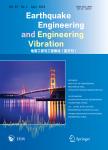Experimental study of friction dissipators for seismic protection of building structures
Experimental study of friction dissipators for seismic protection of building structures作者机构:Technical University of CataloniaArchitecture Structures Department Universidad Autónoma de Ciudad JuárezCivil and Environmental Engineering Department Civil Engineering DepartmentUniversity of Bristol
出 版 物:《Earthquake Engineering and Engineering Vibration》 (地震工程与工程振动(英文刊))
年 卷 期:2011年第10卷第4期
页 面:475-486页
核心收录:
学科分类:081405[工学-防灾减灾工程及防护工程] 08[工学] 0818[工学-地质资源与地质工程] 0815[工学-水利工程] 0813[工学-建筑学] 0802[工学-机械工程] 0814[工学-土木工程] 0801[工学-力学(可授工学、理学学位)]
基 金:Supported by Spanish Government Grant CGL2008-00869/BTE
主 题:building structures earthquake engineering passive control friction energy dissipators experimentalverification shaking table tests
摘 要:This paper presents the results from unidirectional shaking table tests of two reduced scale steel models of a building frame, with one and two floors, respectively. These frames incorporate friction dissipators at every floor. The inputs are sine-dwells and artificial and registered earthquakes. This study is part of a larger research project aiming to assess the seismic efficiency of friction dissipators by means of an integrated numerical and experimental approach. Inside this framework, the main objectives of these experiments are to: (i) collect a wide range of results to calibrate a numerical model derived within the project, (ii) clarify some of the most controversial issues about friction dissipators (including behavior for inputs containing pulses, capacity to reduce resonance peaks, introduction of high frequencies in the response, and self- generated eccentricities), (iii) better understand their dynamic behavior, (iv) provide insight on the feasibility and reliability of using simple friction dissipators for seismic protection of building structures and (v) characterize the hysteretic behavior of these devices. Most of these objectives are satisfactorily reached and relevant conclusions are stated.



